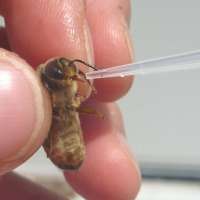Why honey bee sex can be dangerous

A discovery by scientists at UWA that a widespread fungus that causes dysentery in honey bees can be sexually transmitted may impact bee breeding programs world-wide.
A research team at the UWA Centre for Integrative Bee Research (CIBER), working with scientists from The University of Exeter in the UK, discovered the fungus Nosema apis which causes dysentery in bees via faecal contamination can be transmitted from sick male bees to virgin queens.
CIBER Director Professor Boris Baer said the study, published in the international, peer-reviewed journal Scientific Reports, had major consequences for breeding programs.
"To this point, semen used for artificial insemination has typically been regarded as safe, and has been freely shipped around the world," he said. "This finding questions this practice. It calls for additional tests on the semen to avoid spreading the disease across Australia and internationally."
Researchers at CIBER found it takes three weeks until the sperm quality of sick males is affected and they start dying from the disease meaning semen collected for breeding programs may be impacted.
"It also gives them time to fly from the hive and mate, transmitting the fungus to virgin queens who once impregnated, transport it home to their own hives with potentially catastrophic results," said Professor Baer.
Scientists were also able to show that the fungus impacts the productiveness of honey bee colonies. By gluing radio frequency tags onto the backs of honey bee workers, the team found that sick bees were less likely to leave the hive to forage and carried less pollen when coming back compared to healthy ones.
More information: "Consequences of Nosema apis infection for male honey bees and their fertility." Scientific Reports 5, Article number: 10565 DOI: 10.1038/srep10565
Journal information: Scientific Reports
Provided by University of Western Australia



















